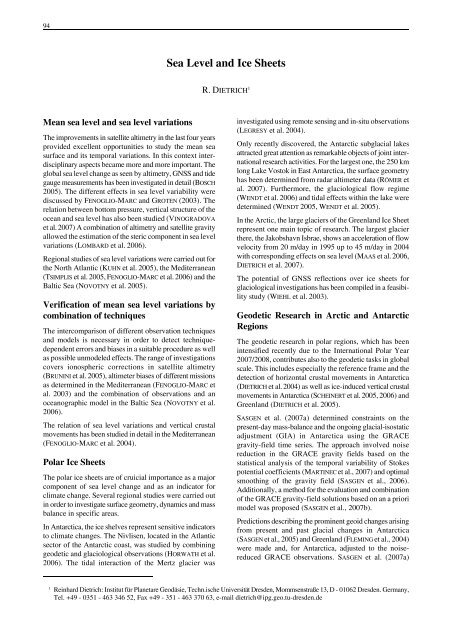NATIONAL REPORT OF THE FEDERAL REPUBLIC OF ... - IAG Office
NATIONAL REPORT OF THE FEDERAL REPUBLIC OF ... - IAG Office
NATIONAL REPORT OF THE FEDERAL REPUBLIC OF ... - IAG Office
Create successful ePaper yourself
Turn your PDF publications into a flip-book with our unique Google optimized e-Paper software.
94<br />
Mean sea level and sea level variations<br />
The improvements in satellite altimetry in the last four years<br />
provided excellent opportunities to study the mean sea<br />
surface and its temporal variations. In this context interdisciplinary<br />
aspects became more and more important. The<br />
global sea level change as seen by altimetry, GNSS and tide<br />
gauge measurements has been investigated in detail (BOSCH<br />
2005). The different effects in sea level variability were<br />
discussed by FENOGLIO-MARC and GROTEN (2003). The<br />
relation between bottom pressure, vertical structure of the<br />
ocean and sea level has also been studied (VINOGRADOVA<br />
et al. 2007) A combination of altimetry and satellite gravity<br />
allowed the estimation of the steric component in sea level<br />
variations (LOMBARD et al. 2006).<br />
Regional studies of sea level variations were carried out for<br />
the North Atlantic (KUHN et al. 2005), the Mediterranean<br />
(TSIMPLIS et al. 2005, FENOGLIO-MARC et al. 2006) and the<br />
Baltic Sea (NOVOTNY et al. 2005).<br />
Verification of mean sea level variations by<br />
combination of techniques<br />
The intercomparison of different observation techniques<br />
and models is necessary in order to detect techniquedependent<br />
errors and biases in a suitable procedure as well<br />
as possible unmodeled effects. The range of investigations<br />
covers ionospheric corrections in satellite altimetry<br />
(BRUNINI et al. 2005), altimeter biases of different missions<br />
as determined in the Mediterranean (FENOGLIO-MARC et<br />
al. 2003) and the combination of observations and an<br />
oceanographic model in the Baltic Sea (NOVOTNY et al.<br />
2006).<br />
The relation of sea level variations and vertical crustal<br />
movements has been studied in detail in the Mediterranean<br />
(FENOGLIO-MARC et al. 2004).<br />
Polar Ice Sheets<br />
The polar ice sheets are of cruicial importance as a major<br />
component of sea level change and as an indicator for<br />
climate change. Several regional studies were carried out<br />
in order to investigate surface geometry, dynamics and mass<br />
balance in specific areas.<br />
In Antarctica, the ice shelves represent sensitive indicators<br />
to climate changes. The Nivlisen, located in the Atlantic<br />
sector of the Antarctic coast, was studied by combining<br />
geodetic and glaciological observations (HORWATH et al.<br />
2006). The tidal interaction of the Mertz glacier was<br />
Sea Level and Ice Sheets<br />
R. DIETRICH 1<br />
investigated using remote sensing and in-situ observations<br />
(LEGRESY et al. 2004).<br />
Only recently discovered, the Antarctic subglacial lakes<br />
attracted great attention as remarkable objects of joint international<br />
research activities. For the largest one, the 250 km<br />
long Lake Vostok in East Antarctica, the surface geometry<br />
has been determined from radar altimeter data (RÖMER et<br />
al. 2007). Furthermore, the glaciological flow regime<br />
(WENDT et al. 2006) and tidal effects within the lake were<br />
determined (WENDT 2005, WENDT et al. 2005).<br />
In the Arctic, the large glaciers of the Greenland Ice Sheet<br />
represent one main topic of research. The largest glacier<br />
there, the Jakobshavn Isbrae, shows an acceleration of flow<br />
velocity from 20 m/day in 1995 up to 45 m/day in 2004<br />
with corresponding effects on sea level (MAAS et al. 2006,<br />
DIETRICH et al. 2007).<br />
The potential of GNSS reflections over ice sheets for<br />
glaciological investigations has been compiled in a feasibility<br />
study (WIEHL et al. 2003).<br />
Geodetic Research in Arctic and Antarctic<br />
Regions<br />
The geodetic research in polar regions, which has been<br />
intensified recently due to the International Polar Year<br />
2007/2008, contributes also to the geodetic tasks in global<br />
scale. This includes especially the reference frame and the<br />
detection of horizontal crustal movements in Antarctica<br />
(DIETRICH et al. 2004) as well as ice-induced vertical crustal<br />
movements in Antarctica (SCHEINERT et al. 2005, 2006) and<br />
Greenland (DIETRICH et al. 2005).<br />
SASGEN et al. (2007a) determined constraints on the<br />
present-day mass-balance and the ongoing glacial-isostatic<br />
adjustment (GIA) in Antarctica using the GRACE<br />
gravity-field time series. The approach involved noise<br />
reduction in the GRACE gravity fields based on the<br />
statistical analysis of the temporal variability of Stokes<br />
potential coefficients (MARTINEC et al., 2007) and optimal<br />
smoothing of the gravity field (SASGEN et al., 2006).<br />
Additionally, a method for the evaluation and combination<br />
of the GRACE gravity-field solutions based on an a priori<br />
model was proposed (SASGEN et al., 2007b).<br />
Predictions describing the prominent geoid changes arising<br />
from present and past glacial changes in Antarctica<br />
(SASGEN et al., 2005) and Greenland (FLEMING et al., 2004)<br />
were made and, for Antarctica, adjusted to the noisereduced<br />
GRACE observations. SASGEN et al. (2007a)<br />
1 Reinhard Dietrich: Institut für Planetare Geodäsie, Techn.ische Universität Dresden, Mommsenstraße 13, D - 01062 Dresden. Germany,<br />
Tel. +49 - 0351 - 463 346 52, Fax +49 - 351 - 463 370 63, e-mail dietrich@ipg.geo.tu-dresden.de











